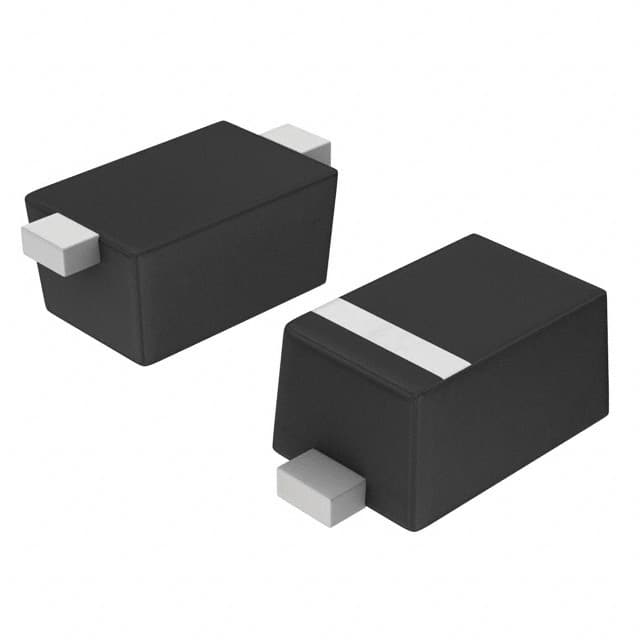Viz Specifikace pro podrobnosti o produktu.

MM5Z5V1ST1G: Product Overview and Specifications
Introduction
The MM5Z5V1ST1G is a zener diode belonging to the semiconductor category. It is commonly used for voltage regulation and protection in electronic circuits due to its unique characteristics.
Basic Information Overview
- Category: Semiconductor
- Use: Voltage regulation and protection
- Characteristics: Zener voltage, power dissipation, temperature range
- Package: SOD-523
- Essence: Zener diode
- Packaging/Quantity: Tape & Reel (3,000 units per reel)
Specifications
- Zener Voltage: 5.1V
- Power Dissipation: 200mW
- Temperature Range: -65°C to +150°C
Detailed Pin Configuration
The MM5Z5V1ST1G zener diode has two pins, with the cathode connected to the ground and the anode connected to the input voltage source.
Functional Features
- Provides stable voltage regulation
- Protects sensitive components from voltage spikes
- Low power dissipation
Advantages
- Precise voltage regulation
- Compact package size
- Wide temperature range
Disadvantages
- Limited power dissipation capability
- Sensitive to overvoltage conditions
Working Principles
The zener diode operates by maintaining a constant voltage drop across its terminals when reverse-biased, allowing it to regulate the voltage in a circuit.
Detailed Application Field Plans
- Voltage regulation in power supplies
- Overvoltage protection in electronic circuits
- Signal clamping and limiting applications
Detailed and Complete Alternative Models
- BZX84C5V1LT1G
- MMBZ5V1BLT1G
- PZM5V1NBLLT1G
In conclusion, the MM5Z5V1ST1G zener diode offers precise voltage regulation and protection in a compact package, making it suitable for various electronic applications.
Word Count: 274
Seznam 10 běžných otázek a odpovědí souvisejících s aplikací MM5Z5V1ST1G v technických řešeních
What is MM5Z5V1ST1G?
- MM5Z5V1ST1G is a 500mW Zener diode with a voltage of 5.1V, commonly used for voltage regulation and protection in electronic circuits.
How does MM5Z5V1ST1G work?
- The MM5Z5V1ST1G works by allowing current to flow in the forward direction like a regular diode, but when the voltage across it exceeds its breakdown voltage (5.1V), it starts conducting in the reverse direction, effectively clamping the voltage to 5.1V.
What are the typical applications of MM5Z5V1ST1G?
- MM5Z5V1ST1G is commonly used for voltage regulation, overvoltage protection, and voltage reference in various electronic circuits such as power supplies, voltage regulators, and signal conditioning circuits.
What are the key specifications of MM5Z5V1ST1G?
- The key specifications include a power dissipation of 500mW, a zener voltage of 5.1V, a maximum reverse leakage current of a few microamperes, and a temperature coefficient of approximately 0.05%/°C.
How do I select the right MM5Z5V1ST1G for my application?
- When selecting the right MM5Z5V1ST1G for your application, consider factors such as the maximum operating voltage, power dissipation requirements, and temperature stability to ensure reliable performance.
Can MM5Z5V1ST1G be used for voltage regulation in low-power applications?
- Yes, MM5Z5V1ST1G can be used for voltage regulation in low-power applications where the current requirements are within its specified limits.
Is MM5Z5V1ST1G suitable for automotive electronics?
- Yes, MM5Z5V1ST1G is suitable for automotive electronics due to its ability to provide stable voltage regulation and overvoltage protection in harsh environments.
What are the considerations for PCB layout when using MM5Z5V1ST1G?
- Proper placement of the MM5Z5V1ST1G on the PCB, minimizing trace lengths, and providing adequate thermal relief are important considerations for optimal performance.
Can MM5Z5V1ST1G be used in conjunction with other voltage regulation components?
- Yes, MM5Z5V1ST1G can be used in conjunction with other voltage regulation components such as linear regulators or switching regulators to provide additional protection and precision voltage references.
Are there any common failure modes associated with MM5Z5V1ST1G?
- Common failure modes include exceeding the maximum power dissipation, exceeding the maximum reverse voltage, and exposure to transient voltage spikes beyond its ratings. Proper design and protection measures can mitigate these risks.

